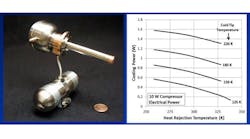It can cost up to ten thousand dollars per pound for a satellite to orbit the Earth. Such costs inspire scientists to continually test new designs and architectures in hopes of producing lighter and therefore more affordable systems. A new satellite cryogenic cooling system, or cryocooler, weighs in at approximately 11 oz.—three times lighter than its predecessor. This lightweight design makes the cooling system optimal for satellites as well as unmanned aerial vehicles (UAVs).
Known as a microcryocooler, the system was developed by Lockheed Martin’s Advanced Technology Center (ATC). Operating in a way similar to a refrigerator, the cooler draws heat out of sensor systems. In doing so, it delivers efficient cooling to small satellites orbiting the Earth and on missions to other planets with an operating lifetime of at least 10 years. The system, which is currently at Technology Readiness Level Six (technology demonstration), delivers 5 to 25 W of power to the compressor from 95 to 105 Hz. It operates between +71°C and -150°C ambient temperature. Any exported vibration is minimized with opposed compressor pistons.
As noted, the microcryocooler also can be used in tactical systems, such as UAVs and tanks. Electronic Design spoke to Dr. Nelson Pedreiro, Director of Science and Technology at Lockheed Martin Space Systems, about the cooler’s UAV status. The system has already completed flight qualifications and is ready for use in flight application systems. But it has not yet been used in an operational UAV flight system. Pedreiro notes that such testing is the main difference between the cryocooler used for satellites and the ones being adapted for UAVs. Its high reliability and long life also should translate directly to reduced maintenance and replacement costs for UAVs.
Lockheed Martin has successfully flown more than 25 cryocoolers in space--most recently on the Wide-field Infrared Survey Explorer (WISE). The WISE mission aims to scan the entire sky for infrared light to discover unseen space objects and answer fundamental questions about the origins of planets, stars, and galaxies. The on-board cryostat keeps the telescope and detectors chilled at 12°K and 8°K, respectively, through two tanks filled with frozen hydrogen. A deployable aperture shade covers the top of the cryostat while on the ground to prevent air from entering. Once a spaceship is safely in orbit, that shade will be ejected. Another shade on top of the system shields the cryostat from heat from the sun and the Earth.
